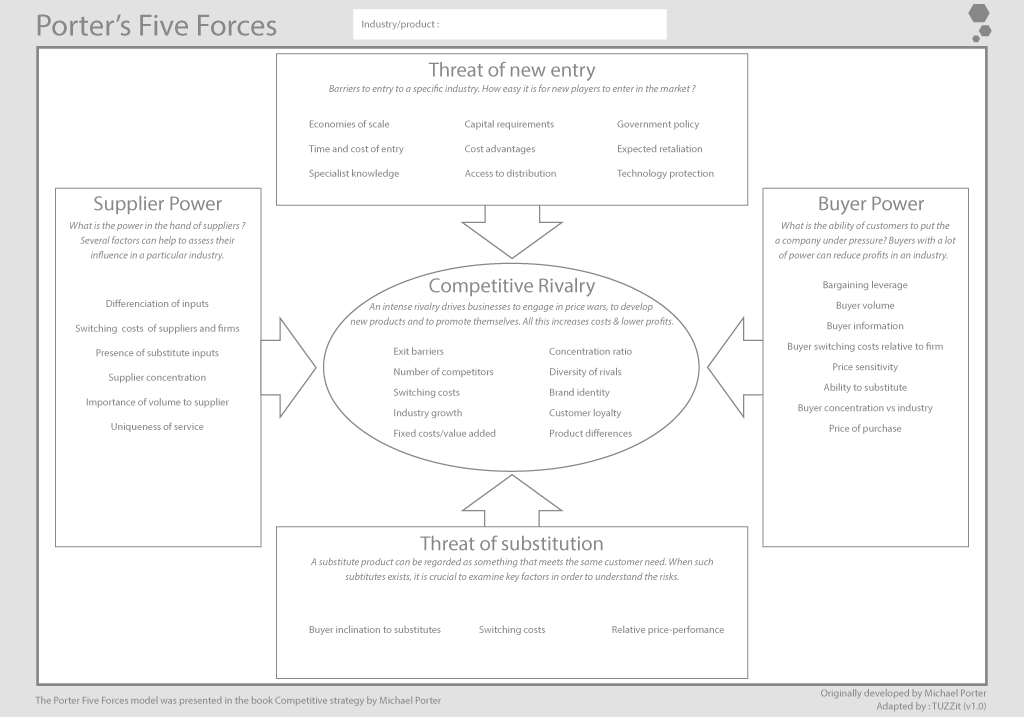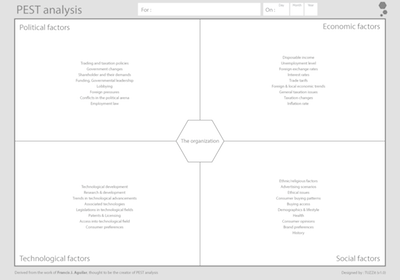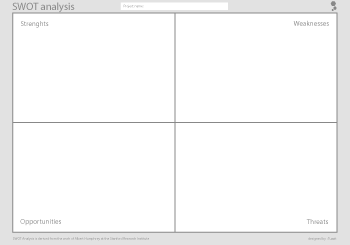Five Forces's Creator
Michaël E. Porter
Michael Porter has worked with governments, corporations and academic circles around the world. He chairs Harvard Business School's program for new CEOs. He described this model in “How Competitive Forces Shape Strategy” ….
Learn More
Description of the Porter's Five Forces
The Porter's Five Forces tool is used to identify and analyse five competitive forces shaping every business and industry. It helps you understand both the strength of your current positioning, but also the strength of your future strategy. You may then use this tool to increase your strategic advantage over competing companies within an industry.
Porter’s Five Forces identifies five forces that determine the long-run profitability of a market or market segment. In order to perform this analysis, ask and answer some important questions concerning the:
-
Power of suppliers
Depending of the industry and the structure of the market, the power lying in the hands of suppliers varies extensively. These ones may be able to greatly influence the producing industry and they are sometimes able to dictate prices by influencing the availability of key materials. To identify the possible threat of a particular segment, ask yourself if your supplier(s) can easily:
Increase prices without suffering from a decrease in volume
Reduce the quantity supplied
Organize in a formal or informal manner
Compete in an environment with relatively few substitutes
Provide a product/material that is a critical part of the end product or service
Impose switching costs on their customers when they depart
Integrate downstream by purchasing or controlling the distribution channels.
The best defence in dealing and diminishing the suppliers’ power is to build win–win partnerships with them and/or to diversify your sources of products.
-
Power of buyers
What is the power of buyers (customers) on the industry? The stronger the buyer power is, the closer the relationship producers/buyers is to what economists refer as a Monopsony. Under these market conditions, the buyer has the most influence in determining the price. To identify the possible threat caused by the buyers’ power on your segment, ask if the buyers have the ability to:
Be “organized” in some form with others providing similar products and services
Purchase a product that represents a significant fraction of the buyer’s costs
Buy a product that is undifferentiated
Incur low switching costs when they change vendors
Be price sensitive, with other options available
Integrate upstream, to purchase the providers of the goods.
To fight the power of buyers, sellers seek to select buyers with less power to negotiate, switch suppliers, or develop superior offers that strong buyers cannot refuse.
-
Barriers to entry/exit
Assessing how easy it is for new players to enter an industry is essential. It helps you understand how quickly the competitive landscape can change. Some industries have bigger barriers than others. For example, manufacturing will have high barriers in comparison to the service industry. Barriers to entry are unique characteristics to each industry and act to maintain the level of profits for current industry competitors.
Barriers to entry arise from several sources:
Patents and proprietary knowledge
Specialized technology or infrastructure
Economies of scale
Government or other binding policy
Barriers to exit work in the same way as barriers to entry. They limit the ability to leave the market and can exacerbate rivalry.
-
Substitute products
The question to ask here is whether or not there are “substitute products” in other industries meeting identical or similar needs for customers. The threat of substitutes often greatly impact competition. It is important to identify such substitute because competitive strategies based on price won’t work as well in these cases. New technologies contribute to competition though substitute products and services. Again, a segment is unattractive or risky when there are actual or potential substitutes for a product.
-
Rivalry
The intensity of rivalry impacts the development of a company’s strategy and success. One of the ways to analyse the level of rivalry is to check the “concentration ratio” (CR) in a particular industry. If a few firms hold large market shares (ie. CR is high), the competitive landscape is less competitive than if many rivals fight over the same shares.
For example, the intensity of rivalry is increased by the following industry characteristics:
Numerous competitors that are particularly strong or aggressive that are competing for the same customers and resources
Declining sales revenues and volumes resulting in slow market growth, creating the need to actively fight for market share
High fixed costs result in an economy of scale effect
High storage costs or highly perishable products
Plant capacity is being added, over and above what is needed to meet demand
Low switching costs for buyers
Low levels of product differentiation
Strategic stakes are high when a firm is losing market position or has potential for great gains
High exit barriers place a significant cost on abandoning the product
A diversity of rivals with different cultures, histories, and philosophies
An industry shakeout
When a rival acts in a way that elicits a counter-response by other firms
Competitors have high stakes – economic and other – and will battle to remain as a player within the segment.
These conditions will make competing within the industry more challenging.



